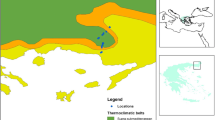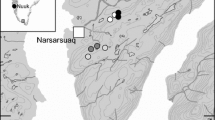Abstract
Understanding how species abundances vary in space and time is a central theme in ecology, yet there are few long-term field studies of terrestrial invertebrate abundances and the determinants of their dynamics. This is particularly relevant in the context of rapid climate change occurring in the Arctic. Arthropods can serve as strong indicators of ecosystem change due to their sensitivity to increasing temperatures and other environmental variables. We used spider samples collected by pitfall trapping from three different habitats (fen, mesic and arid heath) in High-Arctic Greenland to assess changes in individual species abundances over an 18-year period (1996–2014). We calculated annual abundances of each species using a conventional method and compared this to a technique that corrected for the influence of short-term weather variation on arthropod activity. The latter method used the area under the curve of a fitted generalized additive model to measure annual change in abundance of each species. Abundances calculated using each of the two methods did not differ greatly over time nor in direction of climate effects, suggesting that short-term weather-driven activity does not influence interpretation of long-term trends. We used model selection to determine which climatic variables and/or previous years’ abundance best explained annual variation in species abundances over this period. We identified and used 28 566 adult spiders that comprised eight species. Most notably, the abundances of some species (Collinsia thulensis and Erigone psychrophila) have declined during this 18-year period, in response to rising temperatures and snow depth dynamics, which affected snowmelt timing and moisture availability. No species increased in abundance through the study period. Since some species showed no trend in abundance through time and climatic effects were habitat-specific, continued climate change may also affect local species interactions. Long-term monitoring programmes are an extremely valuable means through which to generate empirical data about changes in populations and communities; this is especially pertinent in the Arctic, where climate change is occurring at a rapid rate.





Similar content being viewed by others
References
Arnold TW (2010) Uninformative parameters and model selection using Akaike’s Information Criterion. J Wildl Manag 74:1175–1178. https://doi.org/10.1111/j.1937-2817.2010.tb01236.x
Böcher J, Kristensen NP, Pape T, Vilhelmsen L (2015) The greenland entomofauna: an identification manual of insects, spiders and their allies. Koninklijke Brill, Leiden
Bowden JJ, Buddle CM (2010) Determinants of ground-dwelling spider assemblages at a regional scale in the Yukon Territory, Canada. Ecoscience 17:287–297. https://doi.org/10.2980/17-3-3308
Bowden JJ, Buddle CM (2012) Life history of tundra-dwelling wolf spiders (Araneae: Lycosidae) from the Yukon Territory, Canada. Can J Zool 90:714–721. https://doi.org/10.1139/z2012-038
Bowden JJ, Eskildsen A, Hansen RR, Olsen K, Kurle CM, Høye TT (2015a) High-Arctic butterflies become smaller with rising temperatures. Biol Lett 11:20150574. https://doi.org/10.1098/rsbl.2015.0574
Bowden JJ, Hansen RR, Olsen K, Høye TT (2015b) Habitat-specific effects of climate change on a low-mobility Arctic spider species. Polar Biol 38:559–568. https://doi.org/10.1007/s00300-014-1622-7
CaraDonna PJ, Bain JA (2016) Frost sensitivity of leaves and flowers of subalpine plants is related to tissue type and phenology. J Ecol 104:55–64. https://doi.org/10.1111/1365-2745.12482
Culler LE, Ayres MP, Virginia RA (2015) In a warmer Arctic, mosquitoes avoid increased mortality from predators by growing faster. Philos Trans R Soc B 282:20151549. https://doi.org/10.1098/rspb.2015.1549
DeVito J, Meik JM, Gerson MM, Formanowicz DR Jr (2004) Physiological tolerances of three sympatric riparian wolf spiders (Araneae: Lycosidae) correspond with microhabitat distributions. Can J Zool 82:1119–1125. https://doi.org/10.1139/z04-090
Dornelas M, Gotelli NJ, McGill B, Shimadzu H, Moyes F, Sievers C, Magurran AE (2014) Assemblage time series reveal biodiversity change but not systematic loss. Science 344:296–299. https://doi.org/10.1126/science.1248484
Ekstrøm CT (2017) MESS: miscellaneous esoteric statistical scripts. R package version 0.4-15. https://cran.r-project.org/web/packages/MESS/index.html
Elberling B, Tamstorf MP, Michelsen A, Arndal MF, Sigsgaard C, Illeris L, Bay C, Hansen BU, Christensen T, Steen Hansen E, Jakobsen BH, Beyens L (2008) Soil and plant community characteristics and dynamics at Zackenberg. Adv Ecol Res 40:223–248. https://doi.org/10.1016/S0065-2504(07)00010-4
Elmendorf SC, Henry GHR, Hollister RD, Björk RG, Boulager-Lapointe N, Cooper EJ, Cornelissen JHC, Day TA, Dorrepaal E, Elumeeva TG, Gill M, Gould WA, Harte J, Hik DS, Hofgaard A, Johnson DR, Johnstone JF, Jónsdóttir IS, Jorgenson JC, Klanderud K, Klein JA, Koh S, Kudo G, Lara M, Lévesque E, Magnússon B, May JL, Mercado-Díaz JA, Michelsen A, Molau U, Myers-Smith IH, Oberbauer SF, Onipchenko VG, Rixen C, Martin Schmidt N, Shaver GR, Spasojevic MJ, Þórhallsdóttir ÞE, Tolvanen A, Troxler T, Tweedie CE, Villareal S, Wahren C-H, Walker X, Webber PJ, Welker JM, Wipf S (2012) Plot-scale evidence of tundra vegetation change and links to recent summer warming. Nat Clim Change 2:453–457. https://doi.org/10.1038/nclimate1465
Finke DL, Denno RF (2005) Predator diversity and the functioning of ecosystems: the role of intraguild predation in dampening trophic cascades. Ecol Lett 8:1299–1306. https://doi.org/10.1111/j.1461-0248.2005.00832.x
Finke DL, Denno RF (2006) Spatial refuge from intraguild predation: implications for prey suppression and trophic cascades. Oecologia 149:265–275. https://doi.org/10.1007/s00442-006-0443-y
Hansen RR, Hansen OLP, Bowden JJ, Normand S, Bay C, Sørensen JG, Høye TT (2016) High spatial variation in terrestrial arthropod species diversity and composition near the Greenland ice cap. Polar Biol 39:2263–2272. https://doi.org/10.1007/s00300-016-1893-2
Høye TT, Forchhammer MC (2008a) Phenology of High-Arctic arthropods: effects of climate on spatial, seasonal, and inter-annual variation. Adv Ecol Res 40:299–324. https://doi.org/10.1016/S0065-2504(07)00013-X
Høye TT, Forchhammer MC (2008b) The influence of weather conditions on the activity of high-arctic arthropods inferred from long-term observations. BMC Ecol 8:8. https://doi.org/10.1186/1472-6785-8-8
Høye TT, Sikes D (2013) Arctic entomology in the 21st century. Can Entomol 145:125–130. https://doi.org/10.4039/tce.2013.14
Høye TT, Bowden JJ, Hansen OLP, Hansen RR, Henriksen TN, Niebuhr A, Skytte MG (2018) Elevation modulates how Arctic arthropod communities are structured along local environmental gradients. Polar Biol. https://doi.org/10.1007/s00300-017-2204-2
IPCC-Intergovernmental Panel on Climate Change (2014) Climate change 2014: impacts, adaptation, and vulnerability. Cambridge University Press, New York
Jensen LM, Topp-Jørgensen E, Christensen TR, Schmidt NM (2016) Zackenberg ecological research operations 20th annual report, 2014. Aarhus University, DCE—Danish Centre for Environment and Energy. Aarhus University Press, Roskilde
Kapfer J, Grytnes J-A (2016) Large climate change, large effect? Vegetation changes over the past century in the European High Arctic. Appl Veg Sci 20:204–214. https://doi.org/10.1111/avsc.12280
Kleiber C, Zeileis A (2008) Applied econometrics with R. Springer, New York
Koltz AM, Schmidt NM, Høye TT (2018) Differential arthropod responses to warming are altering the structure of Arctic communities. R Soc Open Sci 5:171503. https://doi.org/10.1098/rsos.171503
Lancaster LT (2016) Widespread range expansions shape latitudinal variation in insect thermal limits. Nat Clim Change 6:618–621. https://doi.org/10.1038/NCLIMATE2945
Lawrence KL, Wise DH (2000) Spider predation on forest-floor Collembola and evidence for indirect effects on decomposition. Pedobiologia 44:33–39
Lawrence KL, Wise DH (2004) Unexpected indirect effect of spiders on the rate of litter disappearance in a deciduous forest. Pedobiologia 48:149–157. https://doi.org/10.1016/j.pedobi.2003.11.001
Lensing JR, Todd S, Wise DH (2005) The impact of altered precipitation on spatial stratification and activity-densities of springtails (Collembola) and spiders (Araneae). Ecol Entomol 30:194–200. https://doi.org/10.1111/j.0307-6946.2005.00669.x
Loboda S, Savage J, Buddle CM, Schmidt NM, Høye TT (2018) Declining diversity and abundance of High Arctic fly assemblages over two decades of rapid climate warming. Ecography 41:265–277. https://doi.org/10.1111/ecog.02747
Lumley T (2017) Leaps: regression subset selection. R package version 3.0. https://cran.r-project.org/web/packages/leaps/index.html
Mazerolle MJ (2014) AICcmodavg: model selection and multimodel inference based on (Q)AIC(c). R package version 2.0-1. http://CRAN.R-project.org/package=AICcmodavgR
McKinnon L, Picotin M, Bolduc E, Juillet C, Bêty J (2012) Timing of breeding, peak food availability, and effects of mismatch on chick growth in birds nesting in the High Arctic. Can J Zool 90:961–971. https://doi.org/10.1139/Z2012-064
Miller-Rushing AJ, Høye TT, Inouye DW, Post E (2010) The effects of phenological mismatches on demography. Philos Trans R Soc B 365:3177–3186. https://doi.org/10.1098/rstb.2010.0148
Myers-Smith IH, Forbes BC, Wilmking M, Hallinger M, Lantz T, Blok D, Tape KD, Macias-Fauria M, Sass-Klaassen U, Lévesque E, Boudreau S, Ropars P, Hermanutz L, Trant A, Collier LS, Weijers S, Rozema J, Rayback SA, Schmidt NM, Schaepman-Strub G, Wipf S, Rixen C, Ménard CB, Venn S, Goetz S, Andreu-Hayles L, Elmendorf S, Ravolainen V, Welker J, Grogan P, Epstein HE, Hik DS (2011) Shrub expansion in tundra ecosystems: dynamics, impacts and research priorities. Environ Res Lett 6:045509. https://doi.org/10.1088/1748-9326/6/4/045509
Polis GA, Myers CA, Holt RD (1989) The ecology and evolution of intraguild predation: potential competitors that eat each other. Annu Rev Ecol Syst 20:297–330. https://doi.org/10.1146/annurev.es.20.110189.001501
Post E, Høye TT (2013) Advancing the long view of ecological change in tundra systems. Philos Trans R Soc B 368:20120477. https://doi.org/10.1098/rstb.2012.0477
R Development Core Team (2015) R: a language and environment for statistical computing. R Foundation for Statistical Computing, Vienna
Roslin T, Wirta H, Hopkins T, Hardwick B, Várkonyi G (2013) Indirect interactions in the high arctic. PLoS ONE 8:e67367. https://doi.org/10.1371/journal.pone.0067367
Schmidt NM, Hansen LH, Hansen J, Berg TB, Meltofte H (2012a) BioBasis manual-conceptual design and sampling procedures of the biological monitoring programme within Zackenberg Basic. Aarhus University Press, Roskilde
Schmidt NM, Kristensen DK, Michelsen A, Bay C (2012b) High Arctic plant community responses to a decade of ambient warming. Biodiversity 13:191–199. https://doi.org/10.1080/14888386.2012
Sikes D, Bowser M, Daly K, Høye TT, Meierotto S, Mullen L, Slowik J, Stockbridge J (2017) The value of museums in the production, sharing, and use of entomological data to document hyperdiversity of the changing North. Arctic Sci 3:498–514. https://doi.org/10.1139/as-2016-0038
Smith TM, Smith RL (2012) Elements of ecology. Pearson Benjamin Cummings, New York
Topping CJ, Sunderland KD (1992) Limitations to the use of pitfall traps in ecological studies exemplified by a study of spiders in a field of winter wheat. J Appl Ecol 29:485–491. https://doi.org/10.2307/2404516
Tulp I, Schekkerman H (2008) Has prey availability for Arctic birds advanced with climate change? hindcasting the abundance of tundra arthropods using weather and seasonal variation. Arctic 61:48–60. https://doi.org/10.14430/arctic6
Tylianakis JM, Didham RK, Bascompte J, Wardle DA (2008) Global change and species interactions in terrestrial ecosystems. Ecol Lett 11:1351–1363. https://doi.org/10.1111/j.1461-0248.2008.01250.x
Vellend M, Baeten L, Myers-Smith IH, Elmendorf SC, Beauséjour R, Brown CD, De Frenne P, Verheyen K, Wipf S (2013) Global meta-analysis reveals no net change in local-scale plant biodiversity over time. Proc Natl Acad Sci USA 110:19456–19459. https://doi.org/10.1073/pnas.1312779110
Walker SE, Rypstra AL, Marshall SD (2003) The relationship between offspring size and performance in the wolf spider Hogna helluo (Araneae: Lycosidae). Ecol Evol Res 5:19–28
Wirta HK, Weingartner E, Hambäck PA, Roslin T (2015) Extensive niche overlap among the dominant arthropod predators of the High Arctic. Basic Appl Ecol 16:86–92. https://doi.org/10.1016/j.baae.2014.11.003
Wood SN (2011) Fast stable restricted maximum likelihood and marginal likelihood estimation of semiparametric generalized linear models. J R Stat Soc B 73:3–36. https://doi.org/10.1111/j.1467-9868.2010.00749.x
Zhao Z-H, Shi P-J, Hui C, Ouyang F, Ge F, Li B-L (2013) Solving the pitfalls of pitfall trapping: a two-circle method for density estimation of ground-dwelling arthropods. Methods Ecol Evol 4:865–871. https://doi.org/10.1111/2041-210X.12083
Acknowledgements
We would like to thank the Greenland Ecosystem Monitoring Programme, especially BioBasis and ClimateBasis, for access to specimens and climate data, respectively, from Zackenberg, Northeast Greenland. We thank the Natural History Museum Aarhus for access to the Zackenberg collection and use of laboratory facilities. We are also grateful for much helpful feedback from anonymous reviewers and the handling editor.
Author information
Authors and Affiliations
Contributions
Author contributions
JJB, OLPH and TTH conceptualized the ideas; JJB identified specimens and generated data; JJB, TTH and OLPH analysed the data; JJB wrote the paper; JJB, OLPH, KO, NMS and TTH contributed to data interpretation, article revision and final approval; NMS was responsible for the collection of specimens under Greenland Ecosystem Monitoring Programme and KO curated all specimens at the Natural History Museum Aarhus.
Corresponding author
Ethics declarations
Conflicts of interest
The authors declare no conflict of interest.
Additional information
This article belongs to the special issue on the “Ecology of tundra arthropods” coordinated by Toke T. Høye and Lauren E. Culler.
Electronic supplementary material
Below is the link to the electronic supplementary material.
Rights and permissions
About this article
Cite this article
Bowden, J.J., Hansen, O.L.P., Olsen, K. et al. Drivers of inter-annual variation and long-term change in High-Arctic spider species abundances. Polar Biol 41, 1635–1649 (2018). https://doi.org/10.1007/s00300-018-2351-0
Received:
Revised:
Accepted:
Published:
Issue Date:
DOI: https://doi.org/10.1007/s00300-018-2351-0




